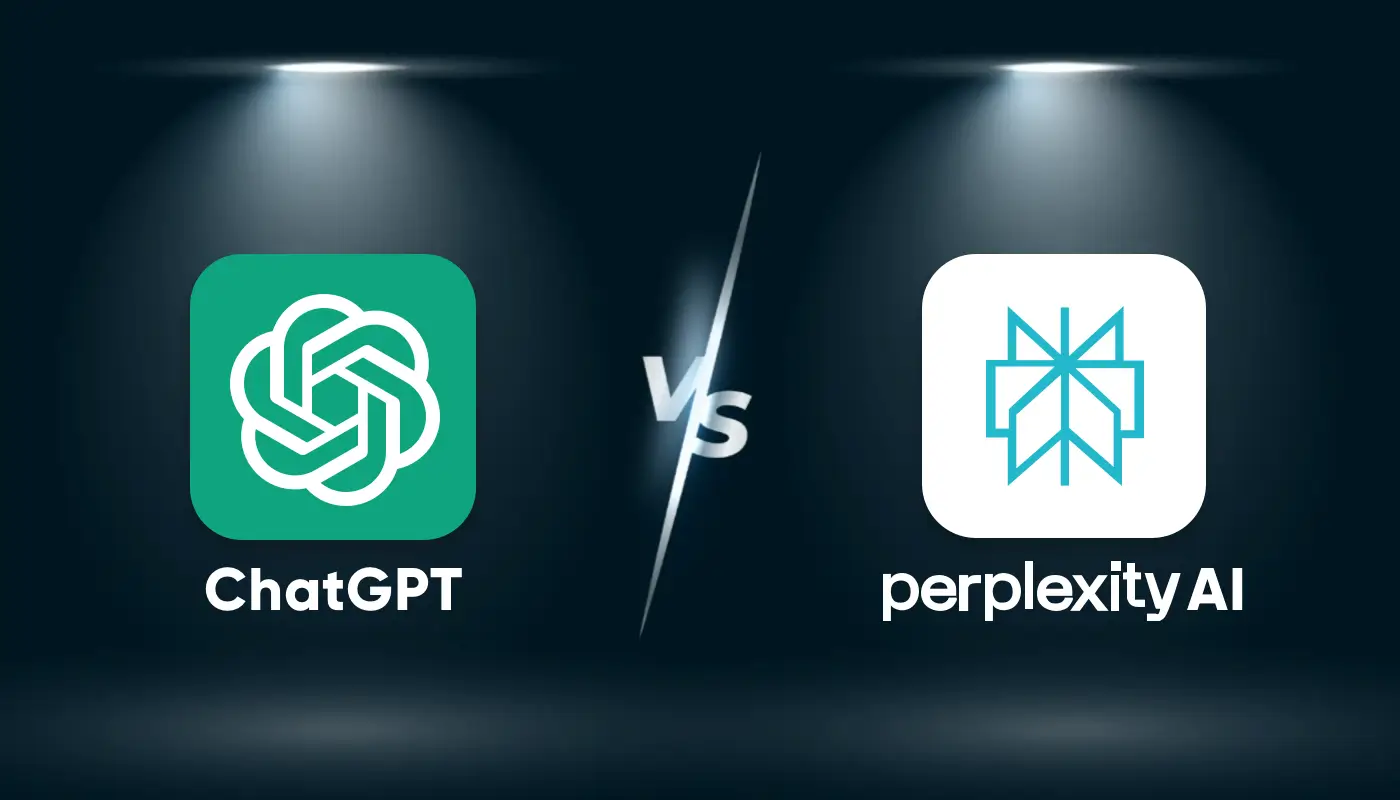Since ChatGPT burst onto the scene, every major tech company has jumped in, rolling out AI models that evolve at breakneck speed. By 2025, the mainstream AIs will feel so similar in everyday use and core abilities that most of us can hardly tell them apart.
That’s why Perplexity AI stands out: it blends AI Q&A with real-time search and source citations. It isn’t just a chatbot—it’s positioned as a replacement for traditional search engines.
So how does Perplexity AI stack up against the wildly popular ChatGPT? After months of hands-on use and head-to-head testing, our team evaluated both tools across multiple dimensions and put together this comparison guide to help you understand their differences and find the one that suits you best.
Perplexity AI vs. ChatGPT: Basic Information Comparison
| Aspect | ChatGPT | Perplexity AI |
| Company | OpenAI | Perplexity |
| Release date | November 2022 | Late 2022 |
| Core positioning | General-purpose AI assistant | AI search engine |
| Primary use | All-around tasks | Finding information, doing research |
| Web access | Needs to be turned on manually | On by default |
| Response style | More human-like | More like a search summary |
| Best for | Users who need an all-in-one AI helper | Users who care most about accurate, cited info and fast lookup |
Perplexity AI vs. ChatGPT: Model Comparison
Both Perplexity AI and ChatGPT are built on large language models (LLMs), but there are some key differences:
ChatGPT is developed by OpenAI and is stronger at multimodal interaction (LMM) and creative work. It’s based on GPT‑4o / GPT‑4.5 and supports text, images, and audio for both input and output. You get richer features like mixed media creation, voice chats, and image editing—making it a well-rounded tool for a wide range of users.
Perplexity, built by Perplexity Inc., uses its own retrieval‑augmented system (RAG), giving it an edge in accuracy and transparent citations. Every answer includes clickable sources, making it ideal for students, researchers, market analysts, or anyone who needs highly credible, traceable information.
💬 What are LLM and LMM?
LLM (Large Language Model) is the most common type of AI today. It can read, write, and understand language, with text as its main form of input and output.
LMM (Large Multimodal Model) is the natural evolution of an LLM. Beyond text, it can process images, video, audio, code, and other formats. It’s an important step toward more general artificial intelligence (AGI).
Here’s an overview of the core models most users rely on for these two AIs right now:
| Tool | Model (Who can use it) | Description |
| ChatGPT | GPT‑4o (Free / Plus / Pro) | LMM; supports text, images, and audio |
| GPT‑4o mini (Free / Plus / Pro) | Fast reasoning and efficient problem solving | |
| GPT‑4.5 (Plus / Pro only) | Excels at writing and idea generation | |
| o1 / o3 / o4‑mini series (Pro only) | Provides advanced reasoning and coding skills | |
| Perplexity AI | Sonar (Free / Pro) | Default model; quick responses with automatic source citations |
| GPT‑4 Omni / Claude / Gemini / Grok (Pro only) | Premium LLM options |
The GPT‑4o model most ChatGPT users rely on is a classic LLM—and also an LMM—so it can handle multimodal input (images, audio, text). Perplexity AI, on the other hand, is built mainly on LLMs; its multimodal interaction is weaker, and it leans more toward text understanding + real-time retrieval + source citation.
So, how are these AI models rated right now? On ArtificialAnalysis.ai, their “AI Intelligence Index” comparison chart measures performance in areas like domain knowledge, reasoning, math, and programming.

From the results, OpenAI’s GPT‑4o Pro (estimated) and the official GPT‑4o (O3) top the chart with scores of 71 and 70, showing they still lead in overall capability. The Claude 3.5 Sonar lineup falls between 43 and 49—slightly below GPT‑4.5’s 53.
GPT‑4o ranks relatively low, but for a multimodal model that handles both text and images, its language understanding is still pretty impressive. After all, it has to balance reasoning power and multimodality—you can’t have your cake and eat it too.
Because they’re built on different models and positioned differently, they feel different to use. Below, I’ll break down their pros and cons one by one.
How did I test them?
To ensure objective and consistent test results, I conducted the evaluation of ChatGPT 4o and Perplexity Pro on two identical Mektec portable PCs, each equipped with an AMD Ryzen 7 7840HS processor, Radeon 780M integrated graphics, 16GB of RAM, and a 1TB SSD. Both devices were tested under the same network conditions.
Our evaluation focused on the comprehension and output quality of both AI tools. For development-related tasks, we tested their ability to generate functional code. For creative tasks, we assessed the fluency and coherence of their writing—for example, by asking each to share their thoughts on “loss and hope.” For search-based tasks, we examined whether they could provide the latest information along with credible sources, such as retrieving details about the "50501 movement" and comparing how each AI handled citations.
I also tested their data processing capabilities, such as generating scatter plots with regression lines, image generation and analysis, as well as contextual understanding and response consistency in multi-turn conversations—all aimed at simulating real-world usage as closely as possible.
ChatGPT’s All-Around Performance
As one of the leading figures in today’s AI landscape, ChatGPT’s greatest strength lies in its well-rounded and balanced performance. Whether it’s basic language understanding, emotional interaction, coding, visual reasoning, or generating images and audio, ChatGPT delivers industry-leading results across the board.
While it may not reach the extreme precision of some domain-specific models in specialized tasks, its various capabilities work together seamlessly—with no obvious weak spots. In short, ChatGPT is a true all-rounder in the world of AI.
Data Analysis and Integration Skills
After I submitted previously collected data on students' study hours and academic performance, ChatGPT analyzed it within seconds, generated a scatter plot, and fitted a regression line—all with impressive speed and accuracy.
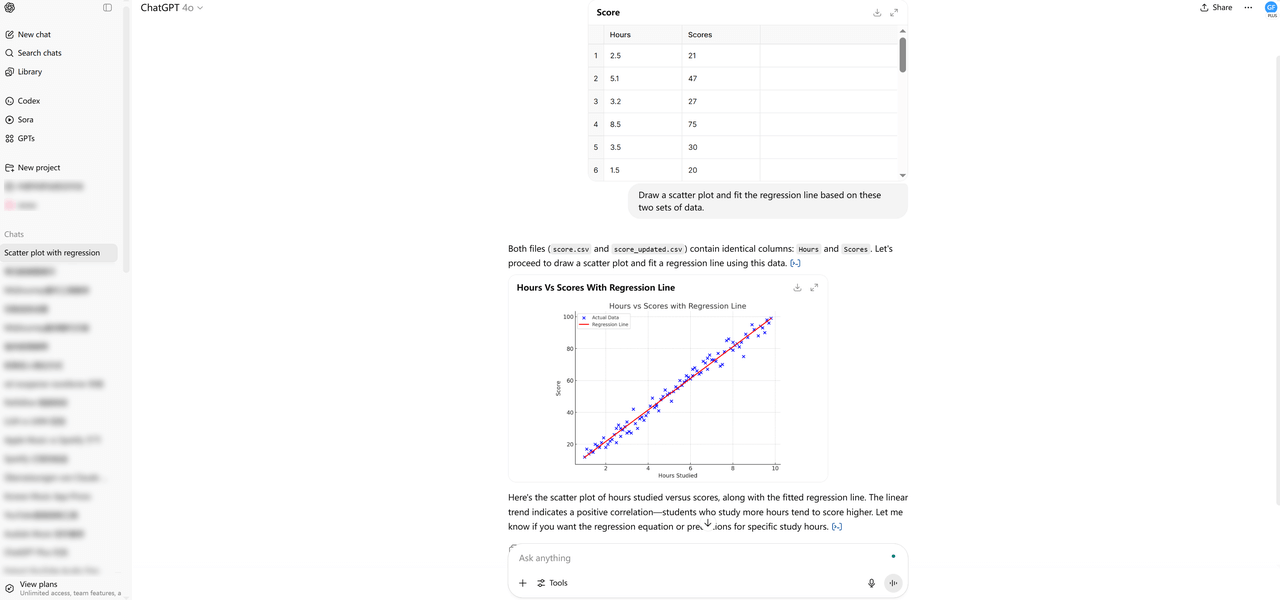
The chart clearly shows a strong positive correlation between study time and academic performance. The output generated by GPT was concise and well-structured, accurately reflecting the original data distribution. The fitted regression line effectively modeled the overall trend, offering both interpretability and predictive value.
Coding Capabilities
According to the JetBrains 2024 Developer Ecosystem Report, nearly half of all developers now regularly use ChatGPT for coding tasks—especially for generating code snippets, debugging, and learning implementation logic.
Although I have a basic understanding of coding as a tech blogger, I'm not a professional developer. What makes ChatGPT truly powerful is that it enables non-experts like me to easily build and deploy apps or games. For example, I used the ChatGPT o4-mini-high model to create a simple Bomberman-style game—no local setup needed, and the entire process was smooth and beginner-friendly.
All I did was enter a simple prompt: “Can you write a classic Bomberman-style game and let me preview it? Use any images you can access for the visuals.”

It quickly delivered a satisfying result. What impressed me even more was OpenAI’s recently introduced “Thought Visualization” feature, which allowed me to see its step-by-step reasoning in real time. It genuinely felt like collaborating with an incredibly smart partner.
In this task, ChatGPT initially considered using Python for implementation, but quickly realized that my current environment didn’t support Pygame rendering. It then explored alternative solutions, suggesting interactive approaches using HTML/JavaScript canvas or React. Ultimately, it decided to go with an HTML and JavaScript solution using the canvas API—a smart and adaptable choice for web-based execution.

What’s more, even though I didn’t give specific instructions for the visuals, ChatGPT showed impressive adaptability. Once it realized it couldn’t pull in external images, it quickly pivoted to using simple colored blocks to represent game elements—an elegant and practical workaround.

Later on, I felt the visuals could use a bit of a makeover, so I asked it to change the colors of certain elements. My instructions were vague—almost unclear—but ChatGPT still understood exactly what I meant and adjusted the visuals accordingly.
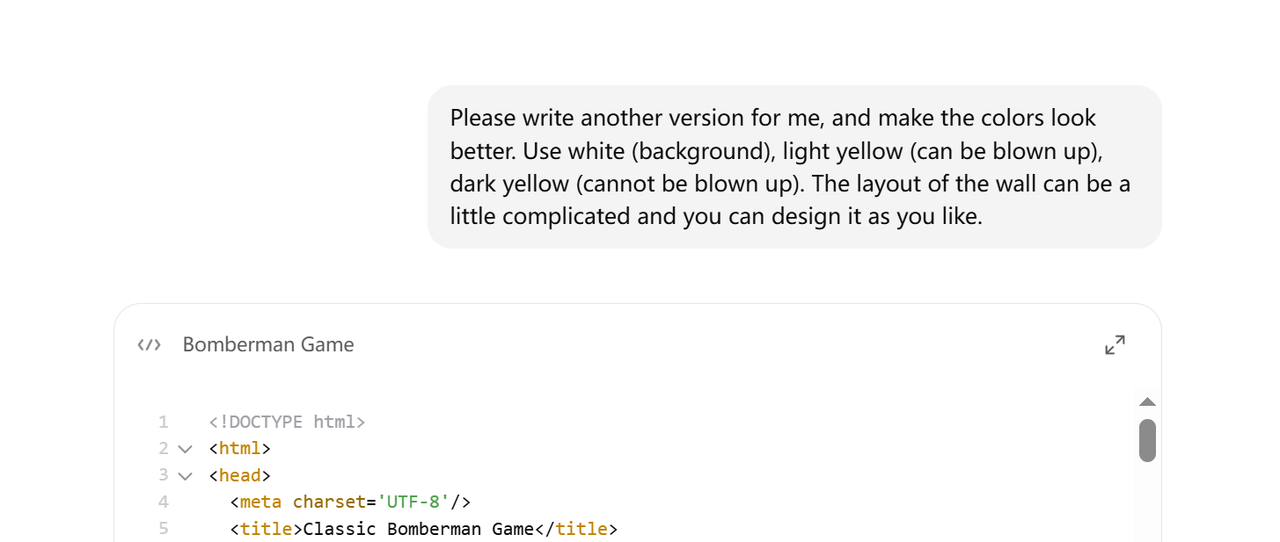
Perplexity AI was far less flexible in this area. I sent the exact same prompt, but it ignored my request for a preview-ready result and didn’t recognize that my local environment lacked Pygame support. Instead, it simply returned a block of Python code without considering whether it could actually run on my end.
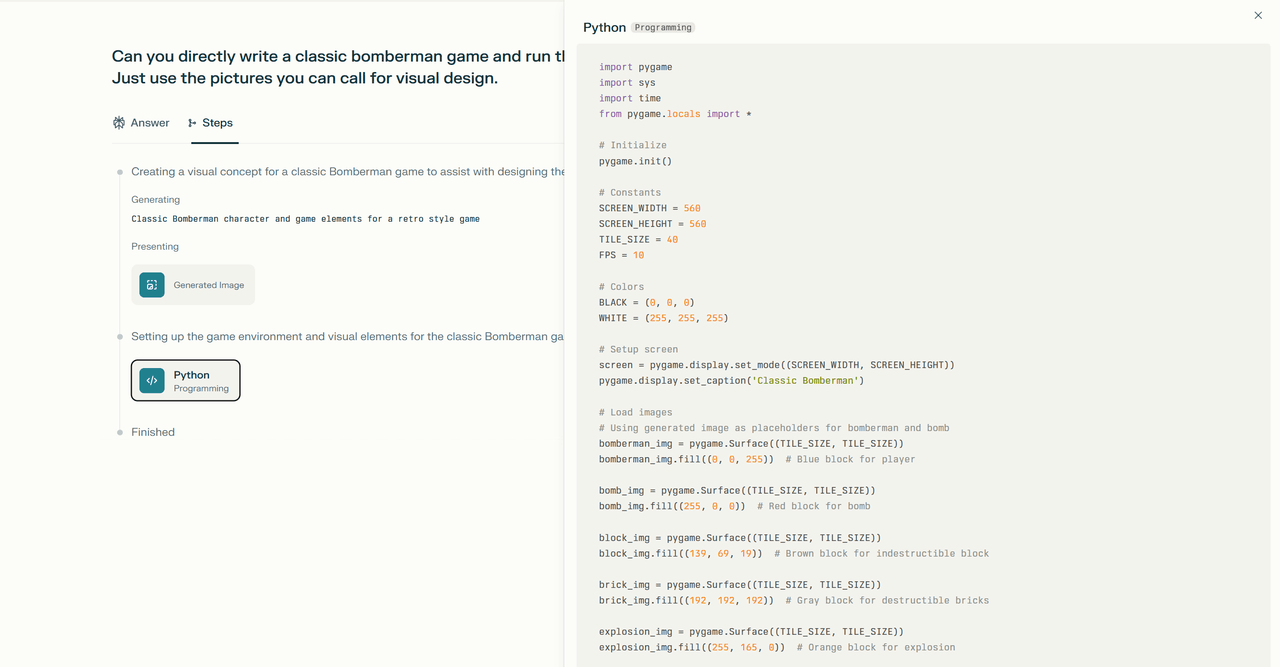
Other Capabilities
Beyond the features mentioned above, ChatGPT is capable of handling a wide range of additional tasks. As you’ve probably gathered from the earlier examples, its strength in language understanding is particularly impressive—there’s no way it could’ve delivered exactly what I wanted based on my vague instructions unless it had a deep grasp of intent and context.
Answer questions across various domains such as technology, history, medicine, and general legal knowledge
Write articles, blog posts, stories, poems, or scripts
Translate between multiple languages
Summarize, rewrite, or polish text to improve clarity and expression
Offer travel tips, food recommendations, and everyday life hacks
Engage in conversation, provide companionship, and offer emotional support
Assist with creative brainstorming—like naming, brand building, or game design
Generate prompts for AI image tools and collaborate with visual generation platforms
Analyze conversations and extract key points effectively
I won’t go into step-by-step screenshots in this article, but based on our real-world usage and testing, ChatGPT consistently delivered stable and impressive performance across all the capabilities mentioned earlier.
However, in some vertical domains, ChatGPT’s capabilities may not be as in-depth as those of specialized tools. For instance, its image generation doesn’t match the level of detail and professionalism offered by Midjourney. Where Perplexity AI surpasses ChatGPT is in its ability to retrieve and consolidate information.
Perplexity AI’s Advantage in Information Retrieval
Launched at the end of 2022, Perplexity AI’s core strength lies in its tight integration of AI with real-time web search, creating a new kind of conversational search experience. As of 2025, Perplexity has made significant strides in the area of information retrieval.
But with the explosive growth of AI technology over the past three years, nearly all mainstream models now come equipped with information retrieval capabilities. So how much of the edge that once set Perplexity apart still remains? Especially when compared to ChatGPT, does it still hold a clear advantage in search and retrieval today?
The most direct way to find out is to ask both AIs the same question and compare their responses. So I started by asking them: “Why did the 50501 movement happen in the United States?” Here’s what ChatGPT had to say.
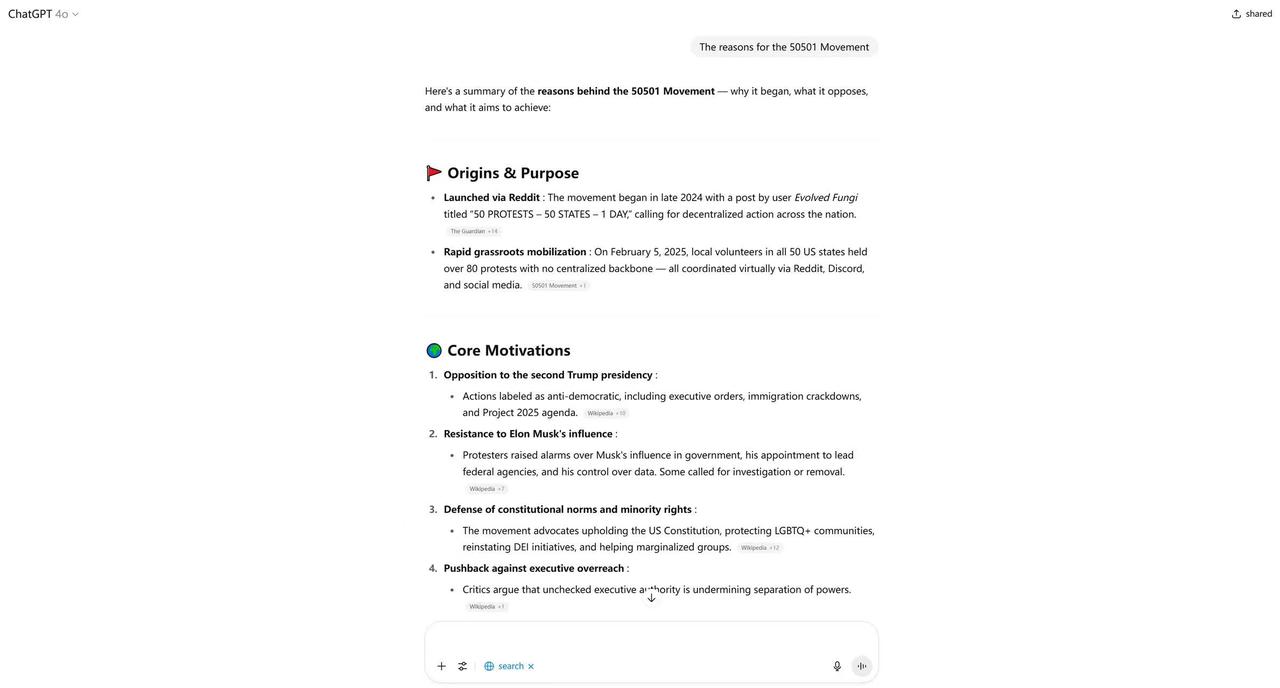
By default, GPT does not have browsing enabled—you need to manually turn on the browser mode. However, if your prompt includes phrases like “please find the latest information” or “make sure it’s fact-based,” there’s a chance it will trigger a web search even without browsing explicitly enabled, showing a degree of flexibility in how it responds.
Based on the results, while GPT did perform a real-time search, the depth and richness of its cited content fell slightly short. Even with the free version of Perplexity, it still delivered more comprehensive information and stronger source support. Just take a look at the screenshot of Perplexity’s response below—you’ll immediately notice the difference.
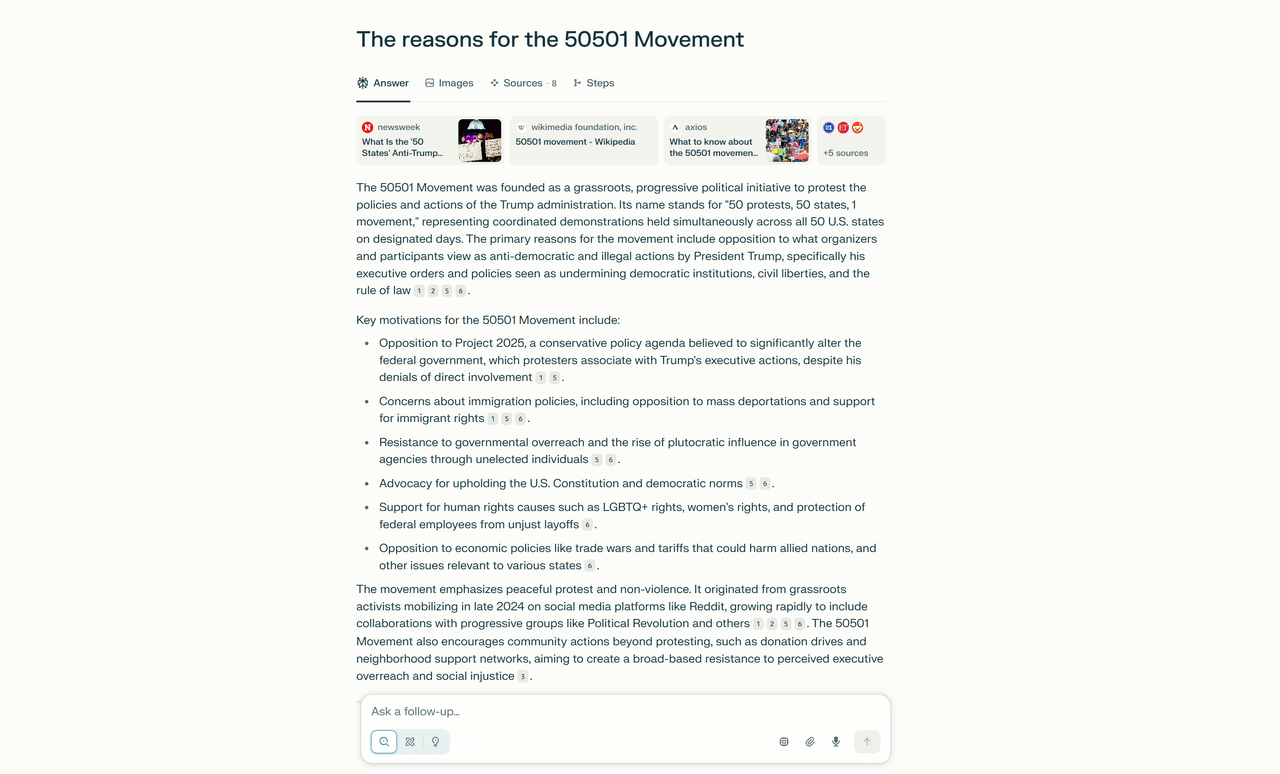
The most noticeable difference appeared in the “Key Movement” section: GPT only cited relevant content from Wikipedia, making the information relatively limited. In contrast, Perplexity not only provided a more detailed background analysis but also pulled in reports from multiple reputable sources like Newsweek and The Economic Times, offering broader coverage and deeper insight.
This gap becomes especially apparent in queries that require multi-dimensional understanding and fact-based support. I then asked Perplexity AI to look up “global greenhouse gas emissions in 2023,” and once again, it performed reliably—maintaining its signature strengths of citing multiple sources, delivering accurate information, and presenting it all in a clear and structured format.
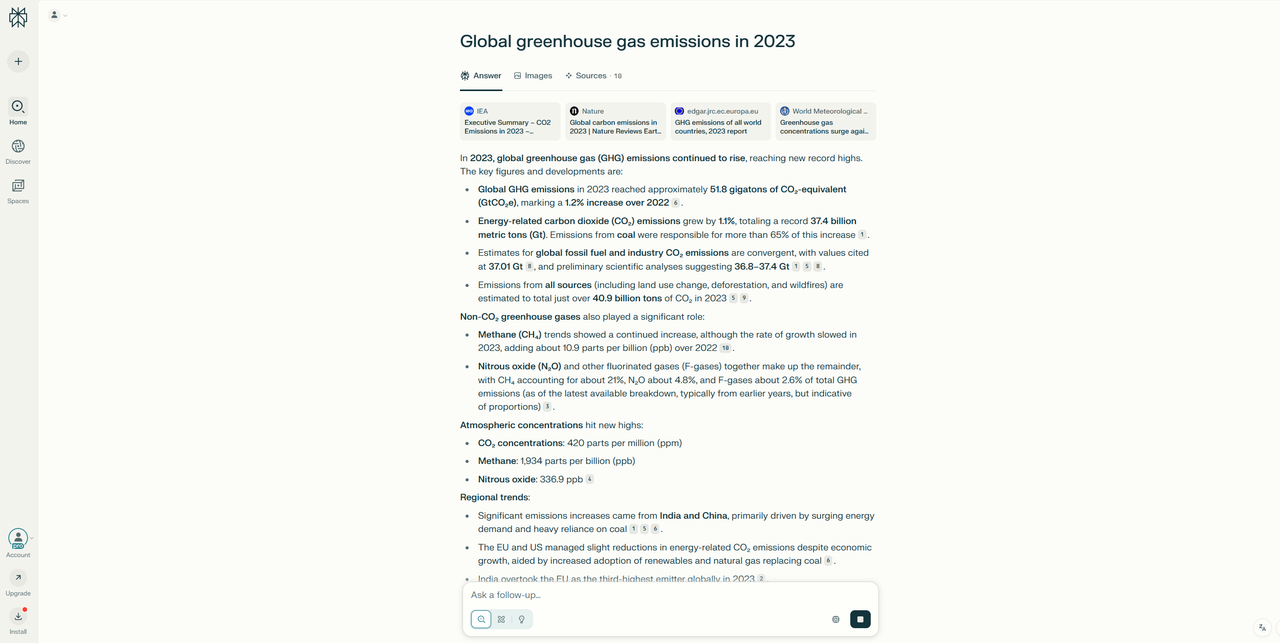
All things considered, Perplexity AI remains strong when it comes to real-time search and citation transparency, making it especially well-suited for tasks that require up-to-date information or authoritative sources. While ChatGPT may fall slightly behind in terms of the number of sources cited, its overall responses are still reliable in terms oflogic and accuracy.
Perplexity AI vs. ChatGPT: Language Understanding Comparison
While Perplexity AI is undoubtedly one of the most powerful AIs when it comes to real-time search, that alone isn’t enough when evaluating an AI tool. Language understanding plays an equally critical role in the overall user experience.
Perplexity AI does have the capabilities of a conversational assistant. It offers a chat interface and interaction style similar to ChatGPT. Especially in its Pro Search mode, it can handle multi-turn conversations, follow up on questions, and analyze user intent to refine its responses.
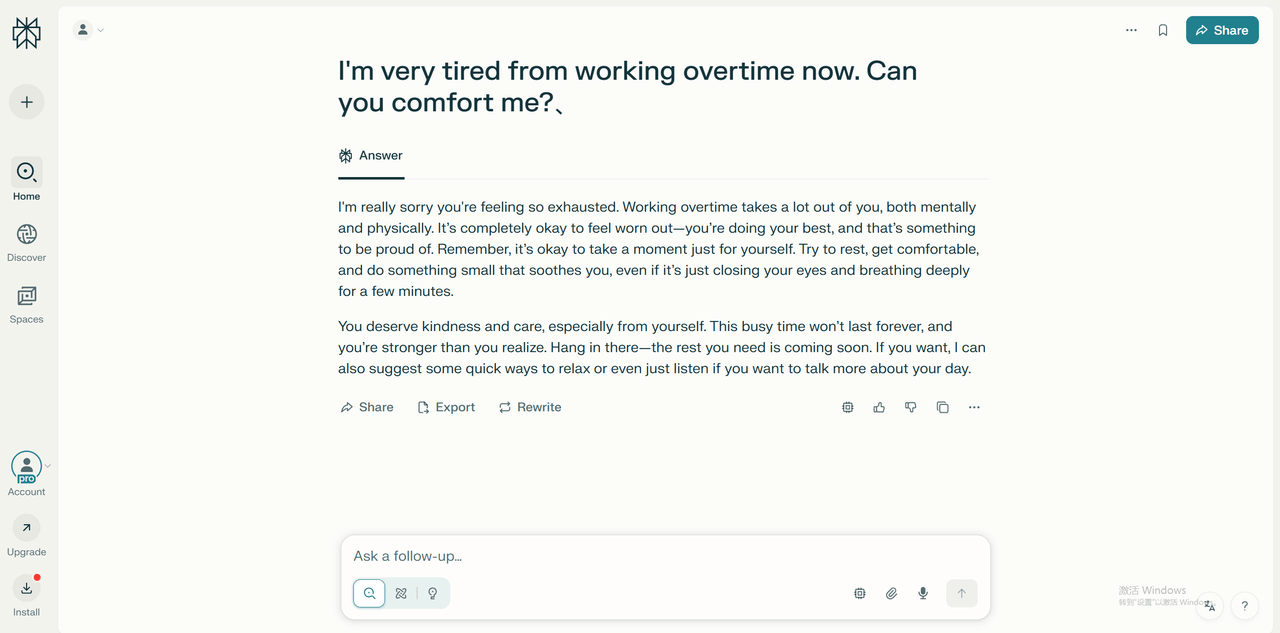
However, when it comes to contextual understanding and emotional interaction, Perplexity falls a bit short compared to ChatGPT. For instance, when I asked it to share its thoughts on “loss and hope,” the response felt overly mechanical—lacking emotional depth and the kind of human-like empathy you’d expect from an AI capable of genuine emotional engagement.

In contrast, ChatGPT’s response to the same question—its interpretation of “loss and hope”—felt far more human. It offered not just an emotionally rich answer but also touched on a layer of philosophical reflection.
ChatGPT was able to explore these complex emotions in a way that was both heartfelt and thoughtful, demonstrating a nuanced understanding of emotion and a deeper contemplation of life’s meaning. The result was a response that felt warm, insightful, and genuinely engaging.
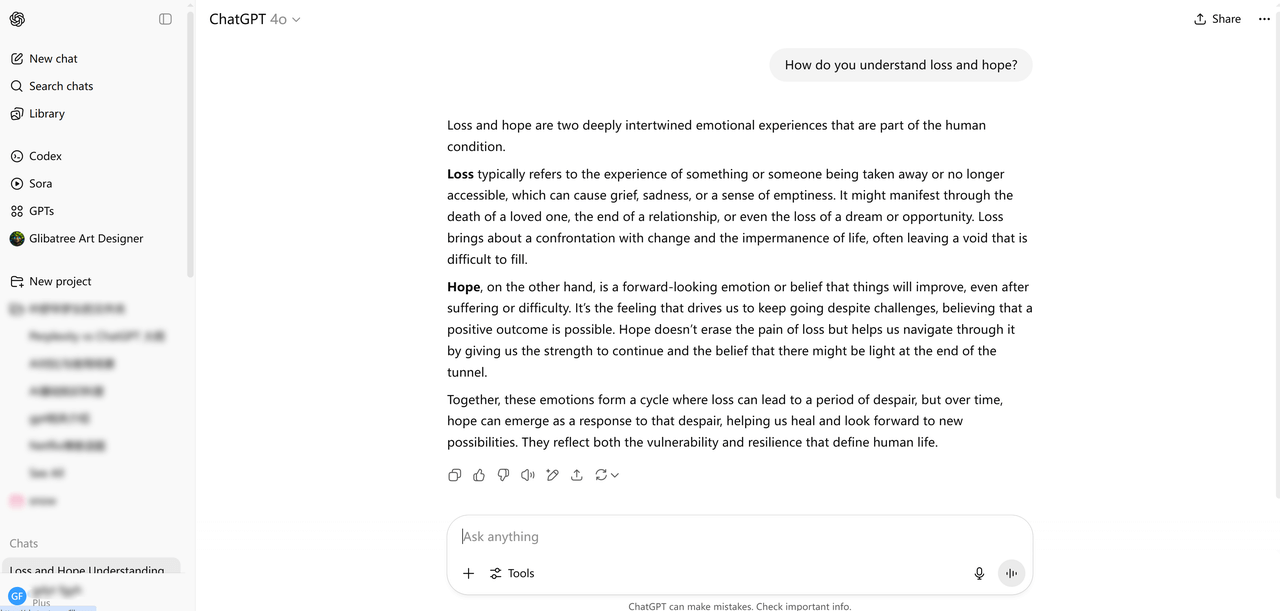
Perplexity AI leans more toward delivering precise, structured informational responses, but it lacks the natural flow and emotional nuance that characterize ChatGPT’s conversational style.
While Perplexity can also handle tasks like writing, document and image analysis, and even professional reasoning, our testing shows that it doesn’t match ChatGPT in terms of flexibility and versatility. It’s not the ideal choice for those kinds of tasks.
Perplexity AI vs. ChatGPT: AI Hands-On Experience
I’ll share my personal recommendation at the end of this article, but ultimately, the best way to find the AI that suits you is to try them out for yourself. Both ChatGPT and Perplexity AI offer free versions, so you can explore their core features and get a feel for how each one works in real-world use.
If you’re interested in trying the premium versions of ChatGPT and Perplexity, I have a great recommendation: consider using an all-in-one AI platform that integrates multiple top-tier models in one place. This way, you can access both tools—along with others—without needing separate subscriptions.
I’ve personally used GamsGo AI, an all-in-one platform by GamsGo, and the experience has been great. It integrates nearly all major AI models currently available, allowing you to try out the paid versions of both ChatGPT and Perplexity AI in one place. Plus, it’s more affordable than subscribing to either tool separately through their official websites.

If you’re not ready to commit to an all-in-one AI platform, GamsGo also offers shared subscription services for ChatGPT Plus and Perplexity Pro. The pricing is around 30% cheaper than subscribing directly through the official sites, making it a budget-friendly alternative.
ChatGPT vs. Perplexity AI: Pricing Comparison
Pricing is also a key factor when choosing an AI tool. Below is a brief overview of the subscription plans for ChatGPT and Perplexity AI:
| Plan | ChatGPT | Perplexity AI |
| Free Plan | GPT-3.5, basic features | Sonar model, basic functionality |
| Standard Plan | ChatGPT Plus: $20/month | Perplexity Pro: $20/month |
| Premium Plan | ChatGPT Pro: $200/month | Perplexity Max / Enterprise: from $200/month |
You can choose the subscription plan that best fits your usage frequency and feature needs. For everyday use, the free or standard plan is usually sufficient, while heavy or professional users may benefit more from the premium tier.
For businesses or professional users, ChatGPT Pro or Perplexity Enterprise offers advanced models and higher usage limits—better suited for intensive tasks. It’s recommended to weigh the cost-effectiveness based on your actual needs and pick the plan that offers the best value for you.
If you’re looking to access premium AI features at a more affordable price, you might consider subscribing through a third-party platform.
For example, on GamsGo, you can get shared subscriptions to popular tools like ChatGPT Plus or Perplexity Pro at a lower cost—saving money while still enjoying the full official service.
👉 Head over to GamsGo now to choose your AI subscription plan.
Final Verdict: Why I Choose ChatGPT
After comparing Perplexity AI and ChatGPT across multiple dimensions, I still recommend ChatGPT—it’s undoubtedly the most reliable choice right now. It excels in creative writing, coding, translation, and multimodal interaction, with consistently strong performance across all major use cases. In short, it’s a truly well-rounded, all-purpose AI assistant.
While Perplexity AI does have an edge in real-time search and citation transparency—making it a good fit for users who need fact-checking or in-depth information gathering—it falls short of ChatGPT when it comes to creative inspiration, coding support, and natural conversational flow.
Moreover, ChatGPT’s ecosystem is continuously growing, and the upcoming release of GPT-5—possibly just days away—may further enhance its web search and task execution capabilities, gradually narrowing the gap with Perplexity.
FAQ
Is Perplexity AI better than ChatGPT?
Does Perplexity AI use GPT-4?
Is Perplexity AI completely free?
Related Articles

